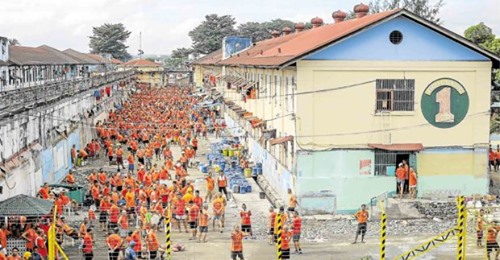MANILA, Philippines — More than 12,000 inmates in all prisons across the country had their gang tattoos covered up in a move the Bureau of Corrections (BuCor) believed would prevent violence inside the overcrowded and gang-dependent penitentiaries.
As of Nov. 12, a total of 11,962 inmates had their gang tattoos removed under the “Oplan Bura Tatak” program, the BuCor reported.
Of that number, 6,804 were prisoners in New Bilibid Prison in Muntinlupa City.
Most of those who got their gang tattoos removed were inmates in Bilibid’s medium security compound, 5,598, followed by 636 prisoners in the maximum security compound. At the Reception and Diagnostic Center, where newly convicted inmates are housed, 447 got their tattoos erased.
Completing the list were 117 inmates in the minimum security and six convicts who were freed but returned to Bilibid because of a question about their good conduct time allowance.
‘Remorseful’
Other inmates also had their tattoos removed: 2,484 in the Iwahig Prison and Penal Farm in Palawan; 408 in San Ramon Prison and Penal Farm in Zamboanga; 156 in Sablayan Prison and Penal Farm in Occidental Mindoro; and 60 in the Correctional Institution for Women in Mandaluyong.
All of the 2,050 inmates who have gang affiliations in Leyte Regional Prison had their tattoos removed, while the Davao Prison and Penal Farm has been gang free “for some time,” according to BuCor.
Oplan Bura Tatak was initiated by BuCor chief Director General Gerald Banag on Oct. 28—a few weeks after the Oct. 9 riot between rival Sigue Sigue Sputnik and Sigue Sigue Commando gangs at the east quadrant of Bilibid’s maximum security compound.
The riot left nine inmates dead and seven others wounded.
The tattoo removal and even a truce among the gangs have not prevented the more deadly Nov. 9 violence at the east quadrant started by Sputnik and Commando members.
The clash among the warring gangs left four inmates dead, and 64 others, including a jail guard, wounded.
The BuCor found weapons used by the inmates, including two “functional guns” — a .34-caliber and a .38-caliber revolvers—hidden in the ceiling of one of the cells.
The BuCor spokesperson Gabriel Chaclag said the leaders of the gangs were “very remorseful [because] they were not able to control their members.”
The BuCor said it was taking steps to completely eliminate the gang system inside prisons. Chaclag said these were supported by the leaders of the 12 gangs in Bilibid, with some of them even surrendering their tattoo makers.
